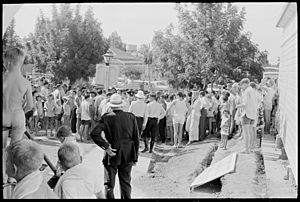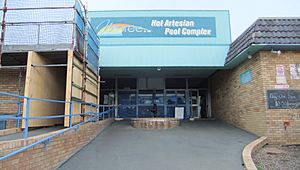Moree Baths and Swimming Pool facts for kids
Quick facts for kids Moree Baths and Swimming Pool |
|
|---|---|

Student Action for Aborigines protest outside Moree Artesian Baths, February 1965
|
|
| Location | Anne Street, Moree, New South Wales, Australia |
| Official name: Moree Baths and Swimming Pool | |
| Type | Listed place (Indigenous) |
| Designated | 6 September 2013 |
| Reference no. | 106098 |
| Lua error in Module:Location_map at line 420: attempt to index field 'wikibase' (a nil value). | |
The Moree Baths and Swimming Pool is a special place in Moree, Australia. It's famous because of a very important event in February 1965. This was when Aboriginal Australians protested there for their rights during the Freedom Ride. This protest helped change how Aboriginal people were treated in Australia. The baths were added to the Australian National Heritage List on 6 September 2013.
Contents
The Freedom Ride Story
In early 1965, a group of university students from Sydney went on a bus trip. This trip was called the Freedom Ride. It was led by an Aboriginal student named Charles Perkins. Their goal was to show everyone the unfair treatment of Aboriginal people in country towns. They wanted to make people aware of racial inequality in Australia.
The idea for the Freedom Ride came from similar "Freedom Rides" in the United States. In America, people were fighting for civil rights and against racial segregation. The Australian students visited towns where Aboriginal people faced discrimination. They wanted to highlight these problems to the whole country.
Why Moree Was Important
The events at the Moree Swimming Baths in February 1965 were a key moment. They showed how Aboriginal people were kept separate from others in towns. This was happening even though the government said everyone should be included. The protests at Moree got a lot of attention from the media. This helped make Charles Perkins a well-known leader for Indigenous people.
The publicity from Moree helped change public opinion. It led to a big "Yes" vote in the 1967 referendum. This vote changed the Australian Constitution. It allowed the Australian Government to make laws for Aboriginal people. This was a huge step towards recognizing Indigenous rights in Australia.
Charles Perkins' Journey
The Freedom Ride was very important to Charles Perkins. He was born in Alice Springs. His mother wanted him to get a good education. So, he went to a special home for Aboriginal boys in Adelaide. Charles faced discrimination from a young age. He once tried to dance at a hall but was told, "We don't dance with blacks." This experience deeply affected him.
Charles was a talented soccer player. He even played in England for a while. But he returned to Australia and continued his studies. In 1963, he started at the University of Sydney. There, he became very active in fighting for Aboriginal rights. He believed Aboriginal people deserved fair treatment and recognition.
Planning the Freedom Ride
The students formed a group called Student Action for Aborigines (SAFA). They were inspired by the American Freedom Rides. Their bus tour aimed to show the problems Aboriginal people faced in rural Australia. They wanted to find out how much racial discrimination was happening. Then, they would tell the public through newspapers, radio, and TV. They also wanted to support Aboriginal people in challenging unfair rules. The group decided to use peaceful protest, like Martin Luther King.
To prepare, SAFA held fundraisers. They also learned about the challenges Aboriginal people faced in New South Wales. Charles Perkins, as the group's chairman, shared his knowledge. He had worked with Aboriginal people needing jobs or housing. He understood the issues they faced.
The Trip Begins: Walgett
The Freedom Ride bus left Sydney on 13 February 1965. Their first stops were Wellington and Gulargambone. They gathered information about unfair treatment. But in Walgett, they took real action.
Walgett had local Aboriginal activists and clear cases of discrimination. The students found that the cinema, the RSL club, hotels, and even a shop kept Aboriginal people out. The manager of one hotel said he wouldn't let Aboriginal people in because his white customers would leave.
The Freedom Riders protested outside the Walgett RSL club. They held signs saying, "Walgett: Australian's disgrace" and "Bar the Colour Bar." This caused a lot of anger among some white residents. The church hall where the students were staying even asked them to leave.
As the bus left Walgett, a truck tried to force it off the road. Luckily, no one was hurt. It turned out that Aboriginal community members were following to protect the bus. This incident showed the strong feelings in the town. The protest encouraged local Aboriginal people to keep fighting for change.
Moree: The Turning Point
At first, not many news reporters were covering the Freedom Ride. But a report about Walgett brought the trip national attention. Newspapers and TV stations started following the students.
In Moree, the situation was similar to Walgett. Aboriginal people were refused jobs and service in hotels. But the main focus was the swimming pool. A local rule stopped Aboriginal people from entering. This was a clear example of official discrimination, like apartheid in South Africa. A local council member, Bob Brown, had tried to change this rule many times, but no one supported him.
The Freedom Riders protested at the Moree council building. The next day, Bob Brown and the students tried to take Aboriginal children into the pool. The pool manager argued with them. Finally, the mayor agreed to let the children in. That evening, the students held a public meeting. They explained their reasons for being in Moree. The audience was mostly white and at first, they were angry. But after discussion, the mood changed. The meeting voted that the rule separating people at the pool should be removed. The mayor said he would take this to the council.
The students left Moree feeling happy that the ban was lifted. But soon after, the pool manager closed the pool and then reopened it, enforcing the old rule. Charles Perkins, who had flown to Sydney for a TV interview, heard the news. The students decided to turn the bus around and go back to Moree.
Back in Moree, the Freedom Riders again tried to enter the pool with Aboriginal children. They tried for three hours. A large, angry crowd gathered outside. People threw eggs and tomatoes. Some students were pushed or punched. Fights broke out, and police arrested some people from the crowd. News reports compared these attacks to what was happening in the American South.
Finally, the mayor of Moree, Bill Lloyd, came to the baths. He told everyone he would sign a paper to remove the old rule. After some talks, the students agreed to leave. They got back on the bus as eggs and tomatoes were still being thrown. Police escorted the bus out of town for their safety.
The Freedom Riders continued their journey, visiting other towns. They kept highlighting unfair treatment. The protests in Moree, with their dramatic photos and news reports, shocked many Australians. They made people realize the difficult lives of Aboriginal people. The Freedom Ride showed that discrimination was still common, even if the government said otherwise.
The Freedom Ride helped lead to the 1967 referendum. This vote changed the Constitution to allow the government to make laws for Aboriginal people. It also helped pass laws against racial discrimination in 1975. The Freedom Ride was a major moment in Australian history. It helped bring about a new era of greater recognition for Indigenous rights.
About the Moree Baths
The Moree Baths and Swimming Pool is located in Moree. It is owned and managed by the Moree Plains Shire Council. The first hot pool opened in 1895. It used natural hot water from the Great Artesian Basin. This water was about 41 degrees Celsius. Over time, the baths were improved. Today, the complex has three tiled pools.
Current Condition
The Moree Baths are still used today and are in good condition. Some parts of the building have been updated since 1965. However, these changes have not affected its importance as a heritage site related to the 1965 Freedom Ride.
Why It's a Heritage Site
The Moree Baths are important because of the student protests in 1965. These protests showed the racial discrimination that Aboriginal people faced. They made many Australians think about how Indigenous people were treated. The protest helped create the public support for the "Yes" vote in the 1967 referendum. This vote was a big step for Aboriginal rights in Australia.
The Moree Baths also have a special link to the life of Dr. Charles Perkins. Moree was where he first publicly challenged unfair treatment of Aboriginal people. The events at Moree, and the whole Freedom Ride, made Charles Perkins a leading Aboriginal activist. He became an inspiring figure for many. It showed his strong dedication to achieving fairness for Aboriginal people throughout his life.
The Moree Baths and Swimming Pool was added to the Australian National Heritage List on 6 September 2013.
Important Events
The Moree Baths are nationally important because of the 1965 student protests. These protests showed the legal segregation and racism in Australia. They made white Australians aware of the discrimination faced by Aboriginal people. The protest helped create the public support for the 1967 referendum. This change in the Constitution helped the government make laws for Aboriginal people. It also led to more recognition of Indigenous rights across Australia.
Important People
The Moree Baths are also important because of their connection to Dr. Charles Perkins. The events there in 1965 made him a well-known Aboriginal activist. It was here that he first used his method of directly confronting people about unfair treatment. This became a key part of his life's work. The events at Moree, and the wider Freedom Ride, made Charles Perkins an iconic figure for Aboriginal people. It clearly showed his lifelong commitment to fairness for Aboriginal people in Australia.
Images for kids








